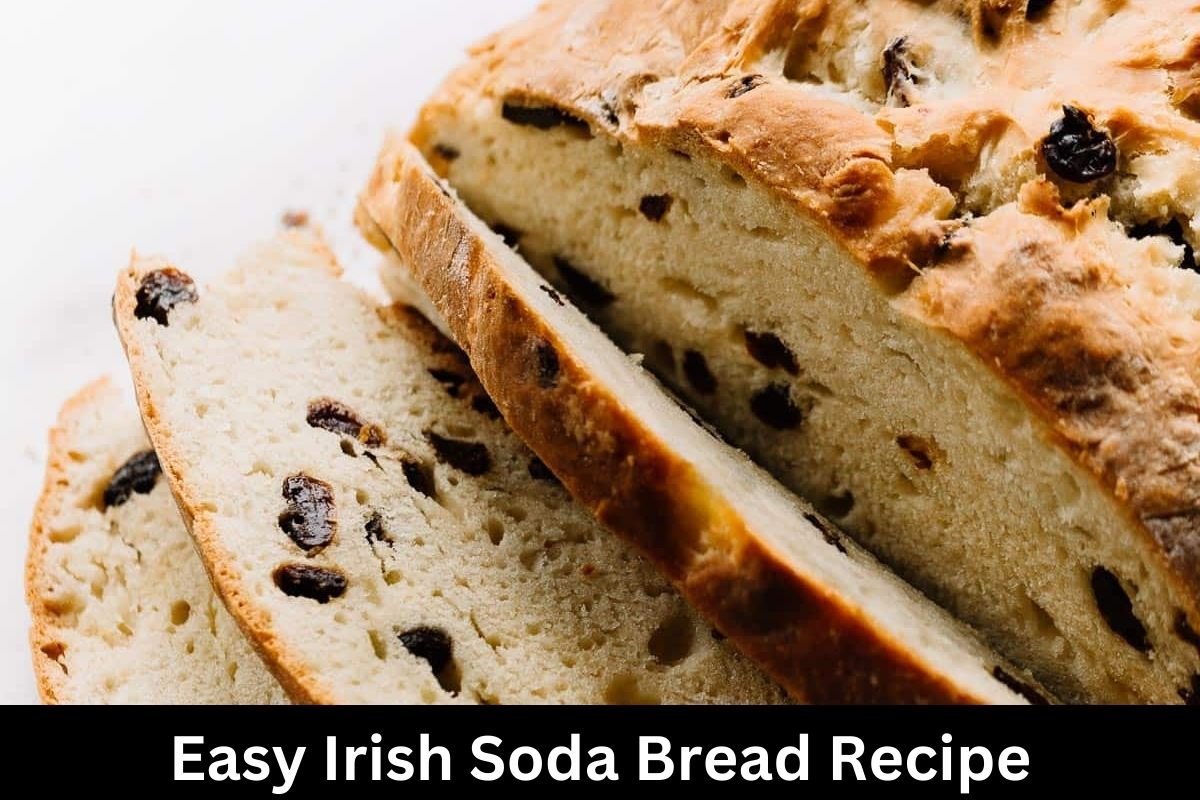Easy Irish Soda Bread Recipe :-Irish Soda Bread is a recipe for a fast bread that does not call for the use of yeast. Baking soda and buttermilk are the only factors that contribute to the leavening of this recipe. My grandmother is the one who came up with this recipe for Irish soda bread, and it has been a favourite in our family for many years. Not only is it dense, but it is also soft, and it has the most incredible crusty cover. The exquisite success of this dish can be attributed to the use of buttermilk and cold butter.
Easy Irish Soda Bread Recipe
Ingredients:
- 1 and 3/4 cups (420ml) buttermilk*
- 1 large egg (optional, see note)
- 4 and 1/4 cups (531g) all-purpose flour (spooned & leveled), plus more for your hands and counter
- 3 Tablespoons (38g) granulated sugar
- 1 teaspoon baking soda
- 1 teaspoon salt
- 5 Tablespoons (71g) unsalted butter, cold and cubed*
- optional: 1 cup (150g) raisins
Instructions:
- For the oven and pan options, preheat: Preheat the oven to 400 degrees Fahrenheit (204 degrees Celsius). Several choices are available for the baking pan.
- Alternatively, you can use a conventional baking sheet and line it with parchment paper or a silicone baking mat (bread spreads a bit more on a baking sheet), or you can use a seasoned 10-12 inch cast iron skillet (you don’t need to preheat the cast iron unless you wish to), or you can grease a 9-10 inch cake pan or pie dish. You might alternatively use a Dutch oven with a capacity of at least 5 quarts. Use parchment paper or grease to line the surface.
- When baking bread in a Dutch oven, make sure the cover is removed before baking.
- Using a whisk, combine the buttermilk and the egg. Put aside for later.
- A big bowl should be used to combine the flour, granulated sugar, baking soda, and salt by whisking them together.
- You can use a pastry cutter, a fork, or your fingers to cut that butter into the mixture. The flour makes up a significant portion of the mixture; nonetheless, you should make an effort to incorporate the butter until it resembles pea-sized crumbs.
- Toss in the raisins and stir. Add the mixture of buttermilk and eggs to the pan. Proceed to gently fold the dough together until it becomes so firm that it cannot be stirred.
- On a surface that has been lightly dusted with flour, pour the crumbly dough. Work the dough into a ball as best you can with
- your hands that have been dusted with flour, and then knead it for approximately thirty seconds, or until all of the flour is moistened. You may need to add a little bit extra flour if the dough is too sticky.
- Transfer the dough to the pan or skillet that has been prepared. You can score the dough with a slash or an X that is approximately half an inch deep by using a very sharp knife or bread lame. The term “score” refers to a shallow incision.
- Bake the bread for around 45 to 55 minutes, or until it has a golden brown color and the center seems to be cooked through.
- If you observe a significant amount of browning on the surface of the bread, tent it loosely with aluminum foil. When the center of the loaf of bread achieves a temperature of 195 degrees Fahrenheit (90 degrees Celsius) on an instant-read thermometer, the bread is considered to be done.
- Take the bread out of the oven and let it cool for ten minutes before transferring it to a wire rack where it can cool
- completely. Serve hot, at room temperature, or toasted, with the toppings or spreads of your choice over the top.
- Leftover bread can be stored at room temperature for up to two days if it is covered and stored, or it can be stored in the refrigerated for up to one week. For the purpose of storage, we often wrap it firmly in aluminum foil.
Notes:
- Baked and cooled bread freezes well for 3 months. Freeze the loaf or slices. Reheat after thawing in the fridge or room temperature.
- Affiliate-linked Special Tools: Cast Iron Skillet, 9-Inch Round Cake Pan, 9-Inch Pie Dish, Dutch Oven, Baking Sheet with Silicone Baking Mat or Parchment Paper, Glass Mixing Bowl, Whisk, Pastry Cutter, Instant Read Thermometer
- Baking Pan: See Special Tools Note for choices. You can use a large baking sheet (with or without a rim), a seasoned 10-12 inch cast iron skillet, or a greased or lined 9-10 inch cake pan or pie dish.
- A loaf pan may not bake the loaf evenly. Flatter loaves work best with this dough.
- Cold buttermilk is finest. Buttermilk gives bread taste, texture, and rise. The bread won’t rise without it. You can produce “DIY” buttermilk if you don’t have any. Whole or 2% milk is preferable, although lower-fat or nondairy milks work too.
- In a liquid measuring cup, add 1 tablespoon lemon juice or white vinegar. Make 1 3/4 cups cold milk. Stir and let sit for 5 minutes before using in the recipe.
- One egg provides richness and depth. It can be skipped for a lighter loaf. No adjustments needed—just remove the egg.
Cold Butter: Dough is less sticky with cold butter. Keep it cold—frozen cubed butter works well. - Divide this dough to make smaller loaves. The bake time will be reduced for larger loaves. Especially useful is an instant-read thermometer. Bake the loaves until an instant-read thermometer reads 195°F (90°C) in the center.
